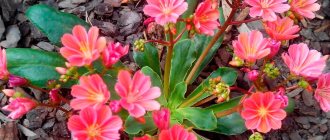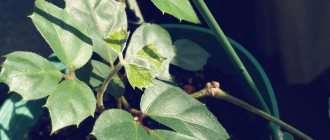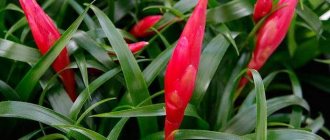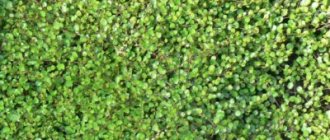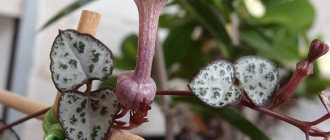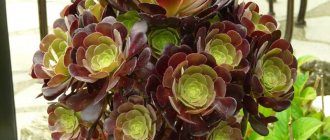Description of plumbago
Blue pigweed comes from South Africa , more precisely, from the Cape Province, the plant belongs to the pigweed family, the botanical name is plumbago.
Most often, the plant is cultivated as a bush plant, but it can also be successfully grown as a canopy plant, because the length of the shoots can freely reach 100 cm. There are 15 known varieties of plumbago .
Flowers of pigweed can be:
- pink (red);
- blue;
- white;
- blue.
Their diameter does not exceed 20 mm. The corolla is symmetrical and consists of 5 petals. The flowers are collected in an umbellate inflorescence crowning the top of the shoot.
The leaf blades are elongated, with a sharp tip, oppositely located, planted on short petioles. The sheet length can reach up to 70 mm.
Origin story
The pigweed spread throughout Europe thanks to Ernest Wilson, who at the beginning of the twentieth century went on an expedition to China, where he encountered an interesting flower in a remote province.
He sent the collected seeds to England to his friend Helen Willmot, who was engaged in growing exotic plants. From the seeds she received, she managed to grow flowers called “Cerato pigweed . The flower quickly spread throughout Britain, and then came to Europe.
Characteristics of culture
Plumbago, a flowering plant from the family Plumbago, is colloquially called plumbago, a derivative of the word “lead” (in Latin “plumbum”). According to one assumption, it received its name because of its chemical properties - it is an antidote for lead vapor poisoning; according to another, the juice of the plant colors tissues in a bluish-blue, pale blue color, similar to the color of metal. Another common version is that the color of the blue or bluish-white petals resembles the shine of a lead surface. In the wild, pigweed is found in the African and Australian tropics, and in the Mediterranean.
Plants from the genus plumbago are herbaceous creeping or climbing shrubs, subshrubs from 0.5 to 3 m in height. Liana-like shoots are covered with spirally arranged elliptical short-petioled leaves up to 12 cm long and about 2 cm wide. The edge of the leaf, narrowed at the base, is entire, sometimes Hairy veins are clearly visible on the surface. Young leaves are green; in some varieties, the lower part becomes whitish with age.
Thanks to the long flexible branches, the bush can be given different shapes:
- standard - the shoots are tied at the bottom, the crown is spherical;
- ampelous - branches hang freely;
- liana-shaped - the stems are tied to a support.
The inflorescence, racemose or spike-shaped, is collected from large (2-3 cm in diameter) almost sessile flowers similar in appearance to a phlox flower, and is formed at the top of the shoot. A corolla of five rounded whitish-blue, white, pink, red petals with a central vein is located on a long (up to 5 cm) tubular calyx. Blooms profusely from March to September. The spread of the plant is facilitated by the viscous gluten secreted by the glands of the flower - the seeds stick to the fur of animals and the feathers of birds.
Varieties
Among the 15 known varieties of pigweed, domestic lovers of exotic plants most often encounter these varieties.
Chinese pigwort, or ceratostigma (Ceratostigma willmottianum)
A compact plant that can be either evergreen or deciduous . The height of the bush is about a meter. The shoots are flexible, thin, covered with reddish bark.
The leaves with small serrations along the edges are planted on short petioles and have a beautiful bluish-green color. The flower petals are colored blue.
Plumbago auriculata (Plumbago auriculata)
In the natural conditions of the homeland, the height of a profusely branching bush can exceed 5 meters. The shoots are covered with elongated lanceolate glossy leaves up to 50 mm in size.
Young leaves are much lighter than mature foliage, which creates an interesting color effect. The flowers are collected in umbrella inflorescences; their color can be blue or white .
Indian pigweed (Plumbago indica)
This red lead , also known as pink lead , is notable for its long (up to 1.5 meters) creeping shoots. Upon contact with the ground, aerial roots form in the leaf nodes. The leaf blades are large, uniformly green, with large teeth along the edge.
Growing problems, diseases and pests
The pig rarely gets sick, but often suffers from attacks by pests. Among the parasites that are especially dangerous are:
- whitefly Its attack is indicated by small white dots on leaf blades and shoots. Provokes yellowing of the bush and falling of leaves and buds;
- mealyworm, which is located on the leaves and covers them with a brown coating. Due to the pest, the piglet begins to wither and normal development stops;
- spider mite, which is almost invisible on the bush. It provokes yellowing and falling of the foliage, which also begins to become covered with cracks.
Pests can cause great harm to the bush
Note! Plumbago most often suffers from improper care. Excessive watering, lack of fertilizing, and lack of lighting affect the healthy growth of the bush.
When fighting parasites, effective drugs are needed - insecticides. The whitefly is destroyed by actellik, commander, and karbafos. Traditional methods often use a warm shower with soapy water. The same method helps cure a bush from mealybugs. To destroy spider mites, it is necessary to irradiate the bush with an ultraviolet lamp and treat it with phytoverm.
Svinchatka is a beautiful hanging plant that decorates the interior of the house. In summer, containers with flowers can be taken out into the garden. The plant needs careful care to prevent the appearance of pests or diseases.
Optimal conditions for growing at home
Pigweed, like any exotic plant, is demanding regarding the conditions of its existence , which does not prevent many gardeners from successfully growing it at home. It is enough to follow a few care recommendations.
Lighting and placement of the pig in the interior
Plumbago needs a lot of sunlight for beautiful lush flowering.
Important! In the summer heat, plants standing on southern windows need to be shaded or moved a little further from the window.
In the winter months, the pigweed is not additionally illuminated , since the plant enters a dormant period at this time and, on the contrary, is removed to a dark, cool place.
View this post on Instagram
Publication from Inna Skosyreva (@skosyreva_inna)
Temperature and ventilation
During the active growing season of plumbago, it is necessary to ensure a temperature of 18 to 25 ° C. In winter, the flower pot is moved to a cool place.
Attention! Do not allow the temperature to drop below 5 °C, as this may lead to the death of the plant.
The room where the pig is located must be regularly ventilated: this will help regulate the temperature during the summer heat.
Watering and air humidity
From the moment the plumbago awakens in the spring until the onset of dormancy, the flower requires abundant regular watering . The soil in the pot should not be allowed to dry out - this will have a detrimental effect on the flowering and condition of the plant itself.
But the air humidity does not need to be increased. Pigweed easily tolerates even air dried by central heating radiators . But it responds normally to regular spraying.
Top dressing and fertilizer composition
Complex mineral compositions for flowering plants will help the pigweed to gain a large number of inflorescences. Microelements are added with watering approximately once every 14 days.
Trimming and shaping the lead
In the spring, dried shoots are cut off, and before the onset of winter dormancy, the length of the branches is reduced by a third of the total length .
The crown of the flower is formed depending on the desired final type of plant. Usually 2-3 core shoots are left intact to wrap around the frame or allow them to curl freely.
Transplantation and substrate
Young plants are replanted annually , this is necessary to give enough space to the fast-growing root system.
Plants older than 3 years are replanted every 2–3 years, changing the top layer of soil annually.
For pigweed you need to choose fertile, heavy soils . A store-bought substrate for flowering plants is suitable, but for better growth it is recommended to mix it with humus.
Plumbago propagation method
Pigweed propagates easily and without much effort by cuttings. They take root quickly and can be immediately rooted in a mixture of soil and sand. The size of the cutting is not so important, the main thing is that it has at least two leaves and the upper point of growth of the shoot. Cut cuttings are rooted in separate cups and placed in light and heat (20°C), regularly moistening the soil. After two weeks, the new seedlings acquire a root system.
Note! For cuttings, cut shoots after spring and autumn pruning of the flower are suitable.
The beauty reproduces well by seeds in small greenhouses. Seed germination is good, sprouts require hardening before planting in separate pots. A plant grown from seeds will bloom only after two years.
Plumbago grows very quickly, producing many shoots and flower stalks
It perfectly fills the entire cavity of light windows; with its help you can create a phytowall or hedge. With proper care, the plant lives up to 10 years, delighting with its abundant and beautiful flowering. But for this, you should study the rules of planting and care.
Features of plant flowering
Flowering begins quite early - in the second half of May - and with proper care lasts until mid-autumn. Plumbago flowers emit a pleasant, unobtrusive aroma, but you should still not place the flower in the bedroom: the smell can lead to headaches.
Period of activity and rest
The active growing season is almost identical in timing to the flowering of the pigweed. From the moment the last flowers fade, the plant enters a dormant period that will last until mid-spring .
Types and shape of flowers
The flowers form an umbellate inflorescence. One inflorescence can contain up to 20 small, symmetrical, five-petaled flowers . The color of the corollas depends on the varietal characteristics; their main range is from white to blue.
Pig in the garden
In the garden in open ground, pigweed can only be grown in countries where there are no frosty winters. She does not need special care. I mulch the ground well under it, water it only in extreme heat and cut off overly long shoots. I wrote earlier that in Kalamata it sometimes freezes at night. The pigweed is sensitive to frost, so it is better to cover it if night frosts are expected.
Pear variety Forest Beauty - botanical description and characteristics of the variety
My oleander next to the oleander
I planted the oleander in my garden under a large oleander with dark pink flowers that grows near the gate. The shoots of the vinica are intertwined with the branches of the oleander, and together these two beautiful plants look unusually impressive, attracting the attention of passers-by. And oleander protects the piglet very well from frost.
Sincerely, Elena Mladinskaya, author of the blog “My Greek Garden”.
- [IFRAME]

